Abstract
The Lake Faro brackish basin (Sicily, Italy) was established as a Global Geosite as a key locality of tectonic coastal lakes, but little research has been devoted to this rare geological and ecological framework. To fill this gap, the main stratigraphical, sedimentological, ecological, morpho-bathymetric, and structural features were reported, linking geodiversity with biodiversity. In Lake Faro, a shallow platform develops alongside a deep funnel-shaped basin, reaching a maximum depth of 29 m. A NNW-SSE trending steep cliff, representing the abrupt transition from the platform to the basin, was interpreted as a dextral transtensional fault (Lake Faro Fault), presumably active since the middle-late(?) Pleistocene. The switches of the steep cliff NW-wards, acquiring an E-W trend, was interpreted as being due to the occurrence of the normal Mortelle Fault, cut by the Faro Lake Fault. Bottom terrigenous deposits consisted of coarse- to fine-grained quartzo-lithic rich sediments deriving from high-grade metamorphic and igneous rocks, whereas bioclasts mainly derived from clam farming actives for several centuries up until today. The Quaternary shallow platform, from top to base, includes the following: (i) soft cover composed of coarse terrigenous and prevalent bioclastic deposits; (ii) hard conglomerates cemented by carbonates; and (iii) siliciclastic coarse deposits of the Messina Fm. In the deep basin, siliciclastic silty loams with minor amounts of bioclastic deposits prevailed in the soft cover. Substrate heterogeneity coupled with brackish-marine gradients are the main factors responsible for an articulate patchiness of different lagoon habitats and related benthic associations, which, according to the Barcelona Convention classification, can be summarized as follows: (i) MB1.541 (marine angiosperms or other halophytes), (ii) MB1.542 (Fucales), (iii) MB5.543 (photophilic algae, except Fucales), (iv) MB5.544 (Facies with Polychaeta), and (v) MB5.545 (Facies with Bivalvia). Typical marine associations, such as rhodolite beds, also occur. Finally, the lake, which has been exploited since the prehistoric age because of its high biodiversity and productivity, maintains some evidence of millennial relationships with the resident human cultures, attracted there by the favorable geomorphological and ecological peculiarities.
1. Introduction
In the Cape Peloro coastal lagoon (CPCL, NE Sicily, Italy), two brackish basins, the Lake Faro (LF) and Lake Ganzirri (LG) basins, fall into two Global Geosites, denoted as the “Morpho-tectonic system of Cape Peloro-Lake Faro” and the “Morpho-tectonic system of Cape Peloro-Lake Ganzirri”. Such sites also belong to a protected natural area, the oriented natural reserve of Cape Peloro, so that both geodiversity and biodiversity are protected. Recent geological and naturalistic investigations have been carried out to provide their scientific inventory of geoheritage and their quantitative assessment [1]. Previous research demonstrated that LF and LG are provided with high scores for scientific value and potential educational and touristic uses. Indeed, the studied morpho-structures proved to be key localities, being developed on low-relief coasts because of Quaternary active faults [1].
Nevertheless, although these coastal lakes are key localities, showing indicators of representativeness, geological and biological diversity, and rarity, they are insufficiently explored, beginning with some basic elements, such as stratigraphy, sedimentology, and sedimentary petrography of the first meters of the soft cover bottom and substrate. Even the current knowledge on their bathy-morphology is inadequate, as it is limited to empirical surveys carried out in the mid-20th century [2]. Similarly, the related submerged habitats are nearly unknown, although lists of species or single records have been published [3].
In this paper, results of structural investigations are described in order to detect, in addition to the well-known macroscale brittle deformation affecting the Cape Peloro peninsula and the surrounding hills, mesoscale structures useful for better interpreting the tectonic origin of the LF morpho-structure. In such a scenario, updated bathy-morphology, initial sedimentological characterization, and initial benthic community identification have been contextually described and interpreted in relationship to historical human interference as a contribution to the knowledge of tectonic coastal lakes, as an uncommon environment on the global scale.
2. Coastal Lagoons
Coastal lagoons, as transitional environments “having permanent or ephemeral communication with the sea but protected from the sea by some type of barrier” [4], include a great variety of typologies, not always rigidly classifiable. Among them, five classes may be distinguished on the base of their origin and barrier typology [4]. On a global scale, most of the lagoons originated because of sedimentary processes, such as the Loch Flugarth in the Falklands [5] or the Kotychi Lagoon in Greece [6], while those of tectonic origin are uncommon. Among the most well-known tectonic coastal lagoons are the Bahia Magdalena and Bahia Almejas coastal lagoons (Mexico), controlled by normal faults, parallel to the Pacific Ocean coast [4], and the Lagoon Nador (Morocco), which originated because of faults oriented orthogonally to the coast [7]. Coastal lagoons are extremely dynamic environments that natural events and human pressure can radically transform, even in short time spans. It is presumable, however, that a tectonic origin may favor relative stability and better habitat conservation. Origin, dynamics, and evolution of lagoons, as well as human impact, are items widely covered in literature worldwide. As an example, lacustrine sediments have been investigated as millennial archives of storm flooding and related forecasting models [5]. Palaeoecological investigations, based on benthic foraminifers and ostracods, have allowed the reconstruction of the Holocene morphological and paleoenvironmental dynamics of the Kotychi Lagoon in Greece [6]. The interaction of natural dynamics and human management of brackish environments has been investigated in northeast Spain, representing a valuable example of multi-millennial coastal evolution in a Mediterranean microtidal zone [8]. Similarly, the Italian Comacchio Lagoons have been investigated as a model for the deep connections between natural processes and long-term human controls [9], as well as the Salpi Lagoon, which has been investigated in terms of Holocene paleoenvironmental and human settlement evolution [10].
3. Geological and Structural Framework
The CPCL is localized on the NE edge of the Peloritani Mountains, an Alpine Mountain chain, composed of a pile of seven thrust sheets and belonging to the Calabro-Peloritani Arc [11,12]. The basements consist of metamorphites affected by high- to low-grade Variscan metamorphism, locally intruded by late Variscan magmatic rocks, except for a few tectonic units [11,12,13,14,15]. Indeed, the Alì-Montagnareale Unit is formed only by a post-Variscan succession affected by Alpine anchimetamorphism [16], whereas the Aspromonte and Mandanici Units are affected by an Alpine overprint [11,12]. Remnants of Mesozoic-Cenozoic sedimentary covers cap some of these units [11,12] (Figure 1).
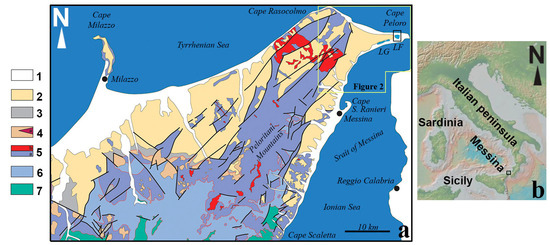
Figure 1.
(a) Geological sketch map of the northeastern sector of Sicily in the Peloritani Mountains (Messina). The study area (LF) in Cape Peloro is evidenced by a black rectangle. Legend: Sedimentary covers—(1) Alluvial and coastal deposits (Holocene). (2) Miocene to upper Pleistocene deposits (including the Quaternary sands and gravels of the Messina Fm). (3) Floresta calcarenites (Langhian-late Burdigalian) and Antisicilide Complex (early Miocene-late Cretaceous). (4) Stilo-Capo d’Orlando Fm (Burdigalian). Tectonic units—(5) Aspromonte Unit (a: Variscan metamorphic basement; b: Plutonic basement). (6) Mela Unit (Variscan metamorphic basement). (7) Mandanici-Piraino Unit (Variscan metamorphic basement and Mesozoic cover). The black square represents the areal extension of the study area. The yellow polygon indicates the localization of Figure 2. The map was modified after [1]. (b) Localization of the study area. The black square represents the areal extension of the geological sketch map (a).
The Calabro-Peloritani Arc is localized in a seismically active region characterized by normal faults and raised Quaternary marine terraces recording the ongoing extension due to the southeastward rollback of the subduction zone [17].
Middle-upper Burdigalian thrust-top basins with siliciclastic sediments seal the tectonic units [11,12,18]. The post-orogenic uplift of the Peloritani Mountains improved a significative erosion of the basements and the sedimentation of siliciclastic successions [11,12,18] (Figure 1).
In particular, the Ionian slopes facing the northern edge of the Messina Strait are composed of Pleistocene thick sequences [11]. These are constituted, from base to top, by the following: middle Pleistocene Messina Fm, upper Pleistocene Mortelle Fm, and upper Pleistocene Case Vento Fm [19,20]. The Messina Fm unconformably overlies the high-grade crystalline basements and the Pliocene-Pleistocene deposits with thicknesses lower than about 250 m (Figure 1). It is composed of sands and gravels with well-rounded particles, deriving from metamorphic and igneous rocks, showing typical clinoforms with foresets dipping towards the central axis of the Strait of Messina [18,19,20]. The Fm, formed in fluvio-marine deltaic environment, shows marine delta lithofacies at the base (gray colored) overlain by continental-transitional deltaic lithofacies (red colored) [21,22,23]. The continental vertebrate contents indicate an age not exceeding 200 ± 40 ky [22]. The Mortelle Fm is formed by sands and silts showing intercalations of marls at the top. The Fm is correlated with the Tyrrhenian terraces deposited in coastal lagoon environments connected with the sea during a phase of incipient regression [18,19,20,21,22,23,24,25]. The Quaternary siliciclastic sequence ends with the Case Vento Fm that consists of sands and gravels of fluvio-marine Gilbert-type fan deltas followed by alluvial plain deposits [18,19,20,21,22,23].
Different orders of marine terraces, overlain by continental silts, sands, and gravels ranging between 236 and 60 ka, unconformably overlie the siliciclastic Quaternary deposits. The origin of these terraces must be looked for in tectonic phenomena and post- Würmian eustatic variations [11,18,19,20,21,22,23,24,25].
The most recent deposits of the CPCL are represented by Holocene coastal and alluvial siliciclastic deposits [26,27]. These sediments are mainly composed of sands and silts with intercalations of gravels, evolving downwards to gravels [28]. Peat intercalations may be present. Stratigraphic data on drilling cores indicate thicknesses ranging between 50 m and 70 m in the Ganzirri-Torre Faro plain [11,25].
Along the shoreline, Holocene hard rocks are extensively exposed along a belt, cropping out for tens of km, from Mortelle (Tyrrhenian coast) throughout Cape Peloro up to Cape Ranieri (Port of Messina in the Ionian coast) [1,26,27,29,30]. These rocks, exposed when not covered by modern beach sands and gravels, are formed by very hard conglomerates with pebbles, cobbles, and boulders in a sandy matrix, cemented by carbonates [29,30]. These particles are composed of granitoids and porphyroids and in general of high-grade metamorphic rocks, dating back to 6 ka B.P. [29]. Evidence of these hard rocks in the drilling cores carried out along the coast is lacking. On the basis of the above, they are interpreted as beach rocks [29,30].
In the NE edge of the Peloritani Mountains, the Pleistocene-Holocene sediments developed in depocenters controlled by extensional structures connected both to the Tyrrhenian Sea opening and the collapse of the Ionian Sea [25]. The source area of the Fm, in the initial stages, was in the Tyrrhenian Sea, before its collapse because of the activity of E-W trending normal faults. Normal and strike-slip faults sometimes may also cut the actual deposits on the sea bottom [25,28,31].
The landscape was shaped by a complex network of faults responsible for the origin of tilted blocks, horst and demi-horst morpho-structures (as the Ganzirri horst [19,20]) onshore, and graben and demi-graben morpho-structures offshore, as revealed by seismic reflection profiles carried out in the Messina Strait Sea bottom [31]. In particular, the main complex array of macroscale faults affecting the Sicilian slope of the Messina Strait may be brought back to the following main fault systems [32]:
- The E-W trending fault system, denoted the Mortelle Fault System [32].
- The NNE-SSW trending fault system (about 15 main macroscale faults denoted n. 45–60 in [32]), denoted the Messina or Messina-Taormina Fault System.
- The NW-SE to NNW-SSE trending fault system (about 8 main macroscale faults denoted n. 61, 62, 64, 65, 66 or without number [32]), denoted the Faro Superiore or Curcuraci Fault System.
- The ENE-WSW trending fault system (about two main macroscale faults denoted n. 63, 66 in [32]), denoted the Scilla Ganzirri or Ganzirri Fault System.
The fault systems were ascribed to extensional tectonics, except the NW-SE to NNW-SSE trending faults (FSFS) characterized by an oblique transtensional displacement with a right lateral component, as reported in several structural and seismotectonic maps of NE Sicily [19,20,32,33,34]. These latter faults were considered right lateral transtensional faults. A transtensional displacement was also confirmed by structural mesoscale data recorded by the authors in the Tindari area (unpublished data) (Figure 2). Physical evidence for the ENE-WSW trending macroscale normal faults is reported on onshore seismic profiles [35,36,37].
The valuable results of a geomorphological and structural research on the modification of the hydrographic network of the Ionian Sicilian slope of the Messina Strait suggested that the WSW-trending drainage system developed in the Late Pleistocene (90–100 ky), as a consequence of the activity of the Faro Superiore or Curcuraci Fault System, whereas the successive drainage system shifted to NNW-SSE trends, developed in the Tyrrhenian as a consequence of the activity of the Scilla-Ganzirri Fault System, actually controlling the present-day trend of the Ionian coast in the northern edge of the Messina Strait [19,20,25], being Quaternary active faults.
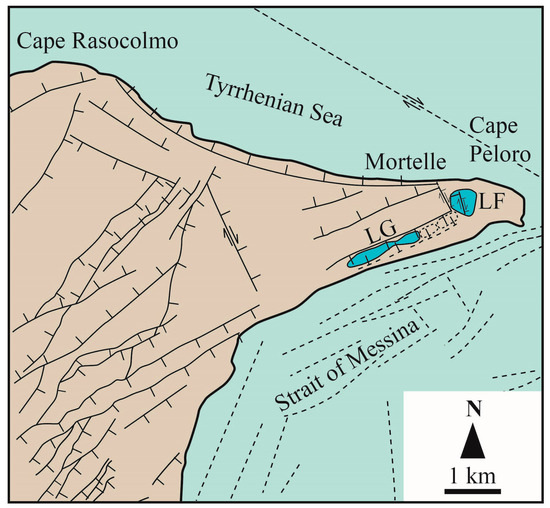
Figure 2.
Sketch of the structural map of the north-easternmost end of the Peloritani chain showing the main fault systems affecting the Sicilian end of the Messina Strait area (E-W trending Mortelle normal fault, NNE-SSW trending Messina normal fault system, ENE-WSW trending Scilla-Ganzirri normal fault system, NNW-SSE trending right lateral transtensional faults Faro Superiore or Curcuraci Fault system). Symbols: Dashes are on the hanging wall of the normal and oblique faults; arrows indicate the right lateral strike-slip component of the movement in transtensional faults. The onshore faults reported with dotted lines are uncertain. Onshore faults are as in [19,20,32,33,34] and the unpublished data of the authors. The offshore faults individuated by means of seismic profiles, reported with dotted lines, are as in [26].
4. The Cape Peloro Coastal Lagoon (CPCL)
The CPCL extends on the north-eastern edge of the Peloritani Mountains, in an area covering about 68.12 hectares comprised among the Torre Faro and Ganzirri fisher villages (Messina, Figure 3) in the Cape Peloro peninsula. The lagoon faces both in the Tyrrhenian and Ionian Sea and hosts two brackish basins, denoted Lake Ganzirri (LG) and Lake Faro (LF).
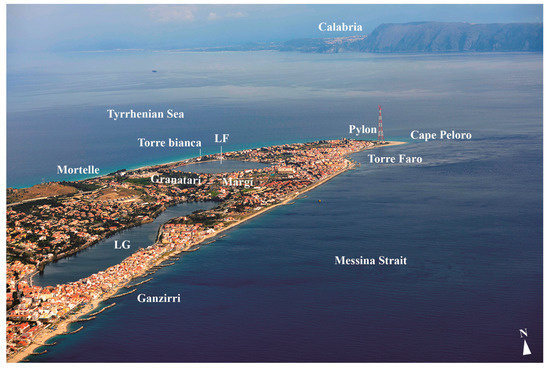
Figure 3.
Oblique aerial photo looking NNE (courtesy of Daniele Passaro) of the Cape Peloro peninsula showing the coastal lagoon with the LF to the north and the LG to the south.
Both basins are located in a crucial protected area, the oriented natural reserve of Cape Peloro (Figure 4), established since 2015. The lagoon was also declared a Site of Community Importance and a Special Protection Zone, according to the European Directives, for its important bioheritage, being a unique brackish environment where the vegetation represents a sanctuary for migratory birds. The lagoon was also designated as a “Heritage of ethnic-anthropological interest”, because of traditional farming of mussels, clams, and cockles [1].
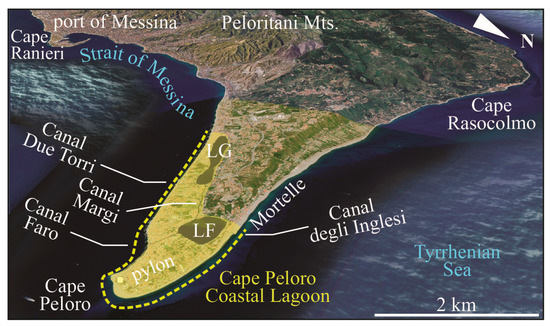
Figure 4.
Cape Peloro. 3D view from NE of the Cape Peloro peninsula and the coastal lagoon (Google Earth pro, satellite imagery).
Moreover, the protected area hosts two geosites, known as “Morpho-tectonic system of Cape Peloro-Lake Faro” and “Morpho-tectonic system of Cape Peloro-Lake Ganzirri” (Figure 4). These two geosites were introduced in April 2015 on the list of the approximately one hundred geosites established by the Sicilian Region. The geodiversity preserved in the lakes provides high scientific value for its peculiar morpho-tectonic origin on the global scale [1].
5. Lake Faro (LF)
LF is a small brackish coastal lake showing a peculiar sub-circular shape, covering an area of about 263,600 m2 (Figure 5). The maximum length (ENE-WSW) and width (N-S) are 600 m and 562 m, respectively. The boundary of the lake is entirely anthropized, being mostly delimited by cemented ramps, streets, and small buildings facing directly toward the lake. The lake is lightly connected to the Ionian Sea through an artificial canal (Canal Faro), about 8 m wide and 425 m long, opening in the Strait of Messina. During the summer, an artificial connection with the Tyrrhenian Sea (Canal degli Inglesi, about 8–10 m wide and 182 m long) is occasionally opened for receiving marine waters to improve the water chemical-physical quality of the lagoon, thus indirectly favoring the local mussel farming activities. Other indirect connections with the sea occur through the Canal Margi (about 8–12 m wide and 904 m long), connecting the SW side of LF with the close LG, on its turn connected with the Ionian Sea through the Canal Due Torri (about 10 m wide and 302 m long) [1].
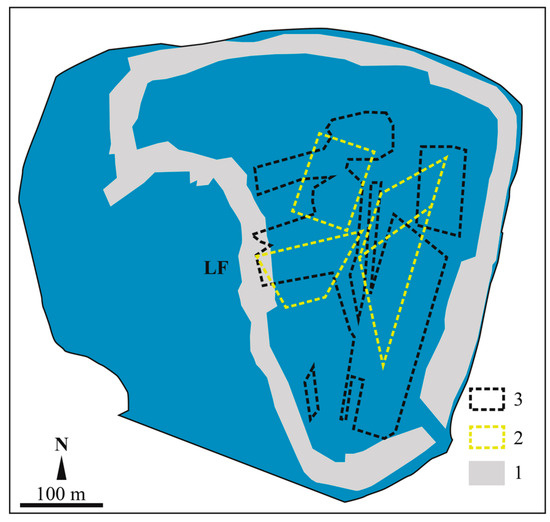
Figure 5.
Map of the LF showing the private properties’ extension and the actual area of the lake covered by farming structures. It is possible to observe the lack of correspondence among the actual area extension of farming structures (2) and the original authorized limits (3). Legend: (1) Private properties; (2) Actual areal extension of farming structures; (3) Original authorized limits.
5.1. Origin of the Lagoon
Two main contrasting hypotheses have been proposed in the past for interpreting the origin of the lagoon.
Segre et al. [29] explained the origin of the deep-seated funnel shape of the LF as depending exclusively on geomorphological phenomena, occurring during the Late Pleistocene-Holocene time span, related to cold currents causing a deep whirl excavation (Figure 6a) of the sea bottom in front of the Faro-Pelorus headland. The eastwards littoral warm currents (Figure 6b), occurring after the previous cold paleocurrents, after the Pleistocene-Holocene transition, determined the formation of a littoral sand bar shoal external to the paleo Lake Faro (Figure 6b), lying on a flat sea floor composed of pebbles and conglomerates. Finally, this littoral warm current circulation became stable about 11,000–9000 years B.P. [29] (Figure 6c).

Figure 6.
Geomorphological phenomena and evolution responsible for shaping the edge of the peninsula of Cape Peloro, during the Late Pleistocene-Holocene time span [29]. (a) Deep whirl excavation because of cold currents (arrows) (Late Pleistocene). (b) Littoral sand bar shoal external to the paleo LF (Pleistocene-Holocene transition). (c) Littoral warm current circulation about 11,000–9000 years B.P. (Holocene) [29]. Legend: (1) Middle Pleistocene substrate. (2) Paleo LF. (3) Coastal deposits. (4) Marine deposits. (5) LF. (6) Actual coast line.
It is noteworthy that the depressions hosting the lagoon with its coastal lakes developed because of the post-orogenic strong extensional tectonics [1] and the subsequent post-Würmian sea-level rise. The first authors to infer a tectonic origin to the LF were, in 1953, Abbruzzese and Genovese [2]. Half a century later, Bottari et al. [30] confirmed a tectonic evolution for CPCL lakes. In particular, the authors showed the results of geological and geophysical surveys. Indeed, an ENE-WSW trending normal fault, the Ganzirri fault, at the base of the hills and bordering the NNW side of LG, was identified in high resolution seismic profiles SM-02 and SM-07 and interpreted as responsible for the formation of the LG [30,35,36]. The fault system was responsible for creating a horst-like morpho-structure, onshore in the hills of Cape Peloro, contraposed to downthrown fault hanging walls on the Ionian coast and the Messina Strait. In the LF area, the authors infer the tectonic origin of the lake to a NW-SE normal fault and another two NE-SW normal faults, located out of the LF area at the base of the hills and the coastal plane, at the west and east of the lake, respectively [30]. After the above-mentioned research, Bottari and Carveni [37] described the occurrence of an ancient port and depicted a morphological and topographical reconstruction of the lagoon. For the first time, a fault was reported in a sketch map inside the LF area [37]. Notwithstanding, this NW-SE trending normal fault was approximately localized in an area corresponding to the middle of the LF platform. After this research, no further structural or geophysical investigations were devoted to the CPCL lakes.
Analyzing the main trends of structural data reported in the major CPCL geological-structural sketch maps [19,20,30,31,32,33,34,35,36,37,38], at least three main fault systems may be recognized. The main macroscale fault systems shaping this landscape are as follows:
- i.
- The E-W trending (N-dipping) normal faults, denoted the Mortelle Fault System.
- ii.
- The NNW-SSE to NW-SE trending (ENE- to NE-dipping) extensional faults with a dextral strike-slip component.
- iii.
- The ENE-WSW trending (SSE-dipping) normal faults.
5.2. Ecological Framework
Literature data indicated that LF is a limno-lagoonar basin [39] with a peculiar meromictic regime that has drawn the attention of specialists at an international level. The above cited peculiarity is tied to the funnel-shaped floor that, hindering the water mixing, separates an upper oxygenated mixolimnion layer, rarely exceeding 15 m depth, from an equally thick sulfide-rich anoxic monimolimnion. The remaining shallow lake floors, affected only by the mixolimnion layer, generally do not suffer from oxygen depletion, except for the 3.5 m in depth small depression, not shown in the historical maps, which is characterized by persistent hypoxic conditions [39].
Surface waters are mesotrophic, and seasonal blooms generally do not cause dystrophic crises [40,41]. However, in the past, greater-than-now seasonal changes in the monimolimnion extent occasionally affected the surface waters, causing water acidification and anoxic crises [42]. As expected in a brackish basin, environmental parameters are subject to marked seasonal and interannual variability. Surface water temperatures range from 13.80 to 29.43 °C, with the lowest temperature of 10 °C in February and the highest of 29 °C in August. Salinity values range from 26.5 to 38.6, and the oxygen concentration in surface waters ranges from 73.82 ± 3.40% to 92.55 ± 7.53% [43,44].
Despite the weak connection with the sea, the mixolimnion is remarkably influenced by the Messina Strait tidal regime and related upwelling, as proven by Saccà et al. [42], who found evidence of sporadic inputs of the Levantine Intermediate Waters (LIW) in LF picoplankton communities. Due to the meromictic regime and close biological implications, microbiological investigations have been carried out since Genovese [45], and LF was proposed as a model under several aspects (e.g., [46,47]). Similarly, the plankton communities have provided case studies at different levels of investigations (e.g., [48,49,50,51]).
The high urbanization of the surrounding area did not hamper the preservation of most original features, although they require continuous protection and enhancement. Among the irremediably lost habitats, the disappearance of a vast area used as salt pans, in relatively recent times (early 20th century), is emblematic. The salt pans reclamation, depriving the brackish area of a relevant and peculiar portion, notably impoverished the whole lagoon system, both in structural, ecological, ethnoanthropological, and cultural heritage.
Tied to the notable anthropogenic pressure, some evidence of chemical (e.g., [52]) and biological contamination (e.g., [53]) has been reported in the past. Mussel and oyster farming (e.g., [54]) are major factors responsible for frequent introductions of non-indigenous species (e.g., [54]).
Although the high naturalistic and ecological value of this brackish area is evident, it has been scarcely documented in the past, by few scientific papers, with regard to avifauna (e.g., [55]) and macrophytes (e.g., [56,57]). Aquatic invertebrates have been mostly reported in recent years, revealing high biodiversity (e.g [58,59]) but also a long-term decline of relevant taxa, such as the mollusks [60]. Some poorly known (e.g., [61]) and endemic species (e.g., [62]) have also been reported. By contrast, the role of LF as a stepping stone facilitating the spreading of marine alien species has been underlined [54].
Currently, the most relevant aspect is given by the persistence of a residual population of the threatened bivalve Pinna nobilis Linnaeus, 1758, which makes the LF one of the latest sanctuaries of this habitat forming species at risk of extinction (e.g., [39,63]).
With regard to the characterization of the main benthic habitats, preliminary data on the occurrence of rhodolith beds were given in [64].
6. Materials and Methods
Investigations aimed to reconstruct the morpho-bathymetry of the bottom and investigate the brittle deformation, texture, and petrographic composition of the sediments and the main habitat typologies of the LF were carried out. The bathymetric instruments and surveying equipment belong to Metralab srl (Padova), whereas the laboratory instrumentations and sampling equipment used for geological and biological investigations belong to the laboratories of geology, forensic geology, and benthic ecology of the University of Messina.
6.1. Sampling Activities and Laboratory Analyses
The soft lacustrine cover and the hard substrate of LF were investigated. Six samples of shallow and deep soft deposits were collected by means of a manual sediment core sampler used during snorkeling and SCUBA activities and of a van Veen bottom grab sampler (400 cm2 surface) used from a traditional fisher boat, respectively. The thickness of the shallow lacustrine cover was measured by means of a graduated metal T-bar. Two samples of hard substrate were also collected.
6.2. Morpho-Bathymetric Reconstruction
In the LF environmental context, bathymetric measurement with a single-beam ultrasound device was considered the most efficient approach. The employment of more expensive tools, such as a multi-beam echo sonar or a laser sonar for measurement, in fact, would not have been significantly compensated for by higher resolution due to the high disturbance caused by the patchy distributed shallowest lake floors and by the numerous sources of lateral reflection, especially scattered anthropic structures. To comply with the recommendations of the International Hydrographic Organization (IHO) [65] regarding frontal waves, a traditional fishing boat was selected. The boat was chosen for its compact dimensions, cost-effective engine, and ease of installation of surveying equipment and instruments.
The bathymetric measurement was carried out using an integrated measuring system. The installed equipment comprised a HydroStar 4300 hydrographic echosounder (ELAC Nautik GmbH, Kiel, Germany) and GNSS devices HyPer Pro (Topcon corporation, Tokyo, Japan), enabling real-time connection and data registration. This setup facilitated the recording of sonar coordinates and corresponding depth. The software Surfer 8.0 automatically converted the GPS coordinates into the local projection coordinates, with the chosen projection being WGS84DD.
The bathymetric survey adhered to pre-established profiles on a geo-referenced cartographic surface. The planned survey profiles ensured comprehensive coverage and high resolution in the research area. Additionally, some transversal profiles were incorporated to intersect with the main profiles, enabling comparison and control of the measured depths. A total of forty measure transects, oriented N-S and E-W, with a spacing of about 15 m, were carried out.
6.3. Habitat
Visual monitoring of the whole shallow lake bottom (<2 m depth) was carried out by snorkeling. Moreover, SCUBA observations were carried out deeper than 2 m depth and up to 15 m depth in the deepest portion of the lake. Main abiotic and biotic features of the lake floor were directly reported on field tablets and photo and/or video documented.
Samples of biogenic bottom deposits as well as specimens of living benthic fauna were manually collected. All main habitat typologies were localized by using a GPS.
Related biocenosis and benthic habitats have been respectively classified according to the Pérès and Picard traditional model [66] and the new updated Barcelona Convention classification for the Mediterranean [67].
Species nomenclature was updated according to WoRMS (World Register of Marine Species) [68].
6.4. Textural Features
Particle size analyses (PSA) of the modern lake sediments were conducted in soft samples.
The analyses of the coarse grain sizes (gravels and sands) were performed using a mechanical sieve (AS 200 control model, Retsch, Düsseldorf, Germany) with sieves provided of the following openings: −1, 0, 1, 2, 3, 4 phi [−log 2 d (mm)]. Additional sieves were used for the analysis of gravelly sands (−4.2, −3.6, −3.2, −2.7, −2.2, −2.0 phi). Due to the significative presence of mud, samples were sieved in wet conditions.
The analyses of the fine grain sizes (silts and clays) [<4 phi (62.5 µm)], after treatment with sodium hexametaphosphate, were performed by means of a diffraction particle size analyzer in wet conditions. The instrument was a laser diffraction particle size analyzer (Mastersizer 2000, Malvern Panalytical Ltd., Malvern, UK) able to measure particles in the size range 0.02–2000 µm. PSA data were expressed in frequency and cumulative per-centage curves. The statistical parameters (mode, inclusive mean, kurtosis, skewness, sorting) were automatically provided by the system Mastersizer 2000.
PSA data of coarse to fine particles were finally expressed in cumulative percentage curves, and the statistical parameters were automatically calculated by means of the software Gradisat 8.0.
The texture of the hard rocks was analyzed at the mesoscale and in polished surfaces realized by precision rock cutting
6.5. Petrographic Composition
The petrofacies were analyzed by means of optical microscopy (OM) under a stereomicroscope and a petrographic microscope. Thin sections of sand with very coarse grains aggregated in epoxy resin were carried out.
The instruments used for OM were a motorized stereomicroscope with reflected and transmitted polarized light (Zeiss Stereo Discovery.V20, magnification from 3.8× to 530× with optical zoom) and a motorized petrographic optical microscope with reflected and transmitted polarized light (Zeiss Imager.M2m model, magnifications from 25× to 500×). Both microscopes were coupled to a telecamera and workstation using image analysis software (Axiovision, Carl Zeiss AG, Feldbach, Switzerland).
Preliminary mesoscale petrographic observations were also carried out in the underlying hard substrate. A visual mesoscale inspection was devoted to pebbles and cobbles in order to characterize their mesoscale petrographic features by means of an eye lens. Due to their evident compositions, textures, and structures, most of these materials were easily classified.
6.6. Structural Geology Analysis
In zones at high seismic risk (zone one, INGV), such as the Calabria-Peloritani Arc, seismogenic faults and fault zones may be detected, identifying the related earthquake sources or acquiring data from geological-structural surveys and geophysical prospections.
Field and satellite imagery observations at macroscale and mesoscale structural investigations were carried out for establishing the presence of active faults at different scales in the most recent deposits. Each workstation was localized by GPS.
7. Results
7.1. Morpho-Bathymetric Reconstruction of LF
The morpho-bathymetric survey allowed the depiction of two main landforms, consisting of a shallow platform at the west and a peculiar deep funnel-shaped floor at the east. This depression shows a maximum depth at −29 m isobath, and its shape is mostly N-S switching, at its NW edge, in an E-W orientation. The shallow platform is sub-horizontal and gently dipping eastwards with depths not exceeding the −2 m isobath, except in a weak NNW-SSE trending small depression, reaching −3.5 m depth (Figure 7). The slope bounding the eastern side of the platform has a steep inclination.
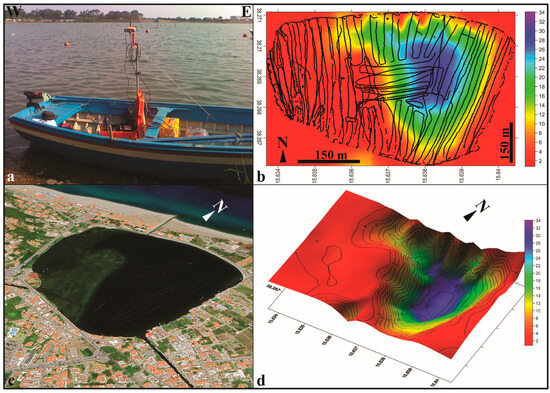
Figure 7.
Morpho-bathymetric survey of LF carried out using a single-beam ultrasound device. (a) Boat with instruments and surveying equipment. (b) 2D morpho-bathymetric color map showing the orientation of the different measure transects. (c) Prospective satellite image of the LF (Google Earth Pro, image date: 11 July 2023). (d) 3D morpho-bathymetric color map showing a weakly E-dipping shallow platform on the western side of the lake (plain in red color) and a basin with a funnel shape (blue to red colors) on the eastern side of the lake.
7.2. Sampling Activity
Six samples of the lacustrine soft cover were collected at a few cm of depth on the lake bottom, along an E-W trending transect crossing the platform and the deep funnel-shaped floor, from west to east, respectively (Figure 8, Table 1). The samples F45–44–46 were collected on the platform. The samples F138–149 were taken on the deep depression. The sample F41 was collected on the western slope of the lake. Two samples of hard conglomerates were collected along the cliff border (Figure 8, Table 1).
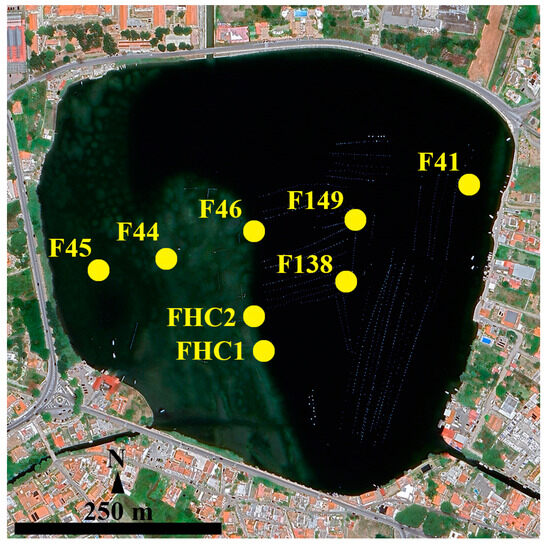
Figure 8.
Map of the samples collected along a transect E-W in the LF.

Table 1.
Geographic coordinates and depths of the samples collected along a transect E-W in the LF, from west to east.
7.3. Stratigraphical and Sedimentological Data on the LF
A modern lacustrine soft cover was identified on the lake bottom from the platform to the deep funnel-shaped floor. The typical blackish color of most of these deposits suggested high amounts of organic matter. The thickness of the lacustrine cover is about 1.5–2 m on the LF shallow platform, whereas along the cliff border, it is only a few centimeters thick or absent due to occasional gravitative slumps.
On the platform, these deposits appear artificially and intensively reworked on the lake bottom, as their composition has been altered by all sorts of anthropogenic materials. Indeed, the lake bottom underwent remarkable anthropogenic alterations due to clam farming activity. The anthropogenic origin of most of the lacustrine cover is testified of by the presence of coarse material composed of entire or fragmentated shells (bivalves and gastropods), due to the shellfish farming activities.
The biotic coarse material prevails on the platform, with the amount of fine siliciclastic sediments being very low, whereas the fine fractions prevail on the deep funnel-shaped floor, with the amounts of biogenic particles being low.
The lacustrine soft cover on the platform overlies a natural hard substrate locally exposed. The substrate, at least 2 m thick, is well observable along the platform and scarp bounding the eastern side of the platform, at about 4 m of depth. The substrate consists of conglomerates whose particles are cemented by carbonates. These conglomerates overlie the gravels and sands of the Middle Pleistocene Messina Fm. This Fm also represents the underlying bedrock of the deep funnel-shaped floor, in turn covered by a layer of various thickness and consistency. A thick nepheloid layer, moreover, widely occurs.
The survey of the stratigraphic boundaries among the soft cover, the hard conglomerates, and the Messina Fm is still in progress, due to the complexity associated with SCUBA activities in identifying them.
7.4. Habitats and Ecosystem Asset
The shell-rich soft cover is colonized by encrusting red algae, frequently forming rhodolith beds (Figure 9a).
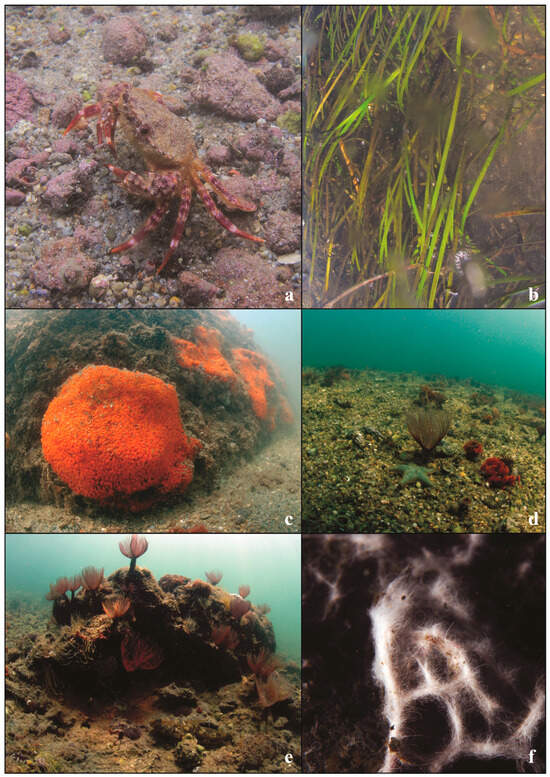
Figure 9.
Natural and anthropogenic habitats in the LF. (a–e) Shallow platform: (a) Portunid crab on a rhodolith bed developed on soft shell deposits, 2.5 m depth (38°16′4.27″ N; 15°38′11.22″ E). (b) Cymodocea nodosa beds developed on soft shell deposits and sands, 1 m depth (38°15′59.43″ N; 15°38′22.96″ E). (c) Natural rocky substrate rising throughout the shallow lake platform, colonized by poriferans, 1 m depth (38°16′2.72″ N; 15°38′13.28″ E). (d) Artificial sandy mounds showing high concentrations of epifaunal and infaunal organisms, 1 m depth (38°16′5.03″ N; 15°38′09.84″ E). (e) Highly colonized remains of an artificial substrate for clam farming, 1.5 m depth (38°16′10.94″ N; 15°38′5.27″ E). (f) Anoxic zone on the western slope of the deep depression, showing microbial matt, 15 m depth (38°16′4.60″ N; 15°38′13.49″ E).
Stable patches of the seagrass Cymodocea nodosa (Ucria) Ascherson, 1870, colonizing both the shell-rich soft cover and the siliciclastic sands, are first reported in the north-western lake borderline and inner part of the Faro canal, respectively (Figure 9b). Similarly, a wide natural hard rocky substrate (composed of conglomerates) with relevant sessile communities, rising throughout the shallow platform and the boundary of the steep cliff, are first reported (Figure 9c).
As an effect of long-time anthropogenic modification of the native habitat, the artificial “sandy mounds” used for clam farming need to be mentioned. Most of the mounds, whose distribution agrees with the cadastral parcels given under concession (Figure 5), are abandoned, and highly colonized by a rich soft bottom fauna (Figure 9d). Moreover, where the wave action removed the mound covering, remnants of artificial hard bases of the mounds, composed of bricks and blocks, emerged, providing an available substrate for flourishing hard-bottom communities (Figure 9e).
However, the most peculiar and large habitat in the LF, extending approximately from −12 m to the maximum depth of the basin, at −29 m, is characterized by anoxic and H2S-rich waters. Due to the anoxic conditions, only microbial communities occur but produce such a high biomass that the resulting bacterial mats are responsible for a varied and impressive underwater landscape (Figure 9f).
7.5. Benthic Biocenosis and Death Assemblages
According to the Pérès and Picard model [66], a generic “Euryhaline and Eurythermal Lagoon biocenosis” can be recognized in the innermost areas, while most lake floors are characterized by the “Superficial Muddy Sand in Sheltered Areas biocenosis”. Instead, according to the Barcelona Convention classification, updated in 2013 [67], the following associations belonging to the “habitats of transitional waters” have been detected:
- i.
- MB1.541 Association with marine angiosperms or other halophytes;
- ii.
- MB1.542 Association with Fucales;
- iii.
- MB5.543 Association with photophilic algae (except Fucales);
- iv.
- MB5.544 Facies with Polychaeta;
- v.
- MB5.545 Facies with Bivalvia.
Inside such associations, a combination of marine and brakish species occurred, resulting in a high degree of biodiversity.
Several non-native species have been also recorded, generally tied to the non-intentional introduction of opportunistic colonizers, throughout the inport, stabling, and farming of shelled edible mollusks. Between such non-native species, the ascidian Styela plicata (Lesueur, 1823) and some annelids such as Branchiomma luctuosum (Grube, 1870) and Branchiomma boholense (Grube, 1878) need to be cited for their extreme invasiveness. By contrast, the settlement of non-indigenous molluscs, such as the mussel Brachidontes pharaonis (Fischer, 1870) and the ark clam Anadara transversa (Say, 1822), did not determine evident ecosystem imbalance.
By contrast, the persistence of some exclusive endemic taxa, such as the annelid Myxicola cosentini (Putignano, Gravili, Giangrande, 2023) [62] and the gastropod Tritia tinei (Maravigna, 1840), is underlined as proof of an ancient genesis of the LF basin.
Death assemblages from the six surface-subsurface soft cover samples provided a large amount of data about the recent and subrecent mollusk fauna, with evidence of changes occurring in historical times. Most recent deposits, indeed, are characterized by large amounts of shells resulting from the stabling of non-native bivalves, such as the “cock”, Callista chione (Linnaeus, 1758), and the Pacific oyster, Magallana gigas (Thunberg, 1793). Ancient, patch-distributed shell deposits of species not living nowadays in LF were also observed, testifying of long-term anthropogenic impacts. Some of these, such as the flat sunsetclam, Gari depressa (Pennant, 1777), are characteristic of coarse sediments and well-oxygenated waters. Other species, such as the brittle cockleshell, Gastrana fragilis (Linnaeus, 1758), are generally associated with marine angiosperms or other halophytes in sheltered environments. Moreover, shells of the gastropod Pirenella conica (Blainville, 1829), known from extreme brackish basins, such as the salt pans, have been sporadically recorded. Notably, all the P. conica specimens showed the peculiar smooth ornamentation and brown color reported for the alleged endemic Cerithium peloritanum (Cantraine, 1835), now synonimized with P. conica. Rarely, partially diagenized shells of the flat oyster, Ostrea edulis (Linnaeus, 1758), testified about the ancient occurrence of this important edible species.
Finally, sediment samples collected in the deepest anoxic zone (F138–149) provided a fraction of coarse bioclasts mostly recognizable as shell remains of both species of farmed mussels, Mytilus edulis (Linnaeus, 1758) and M. galloprovincialis (Lamarck, 1819), related with the overlying long-lines cultures. The same tools are responsible for the release of the abundant sponge silicatic spicules found in the silty fraction at −28 m depth (sample F138).
7.6. Textural Data
Six samples of soft coarse- to fine-grain cover (F45–44–46–138–149–41) were analyzed, as they were, by means of mechanical sieving (in wet conditions; Table 2).

Table 2.
Classification of the soft cover samples, as they were (bioclasts and sediments), on the basis of mechanical sieving.
The soft cover, collected on the platform, consisted of coarse abiotic and biotic deposits with very low percentages of mud. Sample F44 was mainly formed by siliciclastic sandy gravels with a minor amount of clam farming bioclasts in the size fraction < 125 µm (observed under stereomicroscope). Differently, samples F45–46 were composed of clam farming bioclasts in the range between gravelly sands and gravels with sands, prevailing on the abiotic component in the size fraction < 63 µm. Samples F45–46 may be classified as “shell-rich coarse deposits” on the basis of the size of the biotic remains (Table 2).
The soft cover, collected on the deep funnel-shaped floor (F138–149), consisted of siliciclastic muds prevailing on a biotic sand/gravel component of clam farming bioclasts in the size fraction > 63 µm (observed under stereomicroscope).
The soft cover, collected on the western slope of the lake, consisted of abiotic deposits with very low mud. Indeed, sample F41 was mainly formed by siliciclastic gravelly sands with a minor amount of clam farming bioclasts.
Biotic carbonatic traces were found together with the finest mineral matrix in all the samples.
PSA data by laser diffraction on the fraction with size < 63 µm of the soft cover indicated that the fine material mainly consisted of silty loams (F45–44–46–138–149–41). The texture was characterized by low sorting (poorly sorted), fine skewness (rarely symmetrical), and mesokurtic values (rarely platykurtic) (Table 3, Figure 10).

Table 3.
Statistical data on the LF sediments obtained by means of PSA laser diffraction. Acronyms—Percentiles d(0.1), d(0.5), d(0.9): size below which were 10%, 50%, or 90% of all particles. IM: Inclusive mean, IKs: Inclusive kurtosis, ISk: Inclusive skewness, ISD: Inclusive standard deviation.
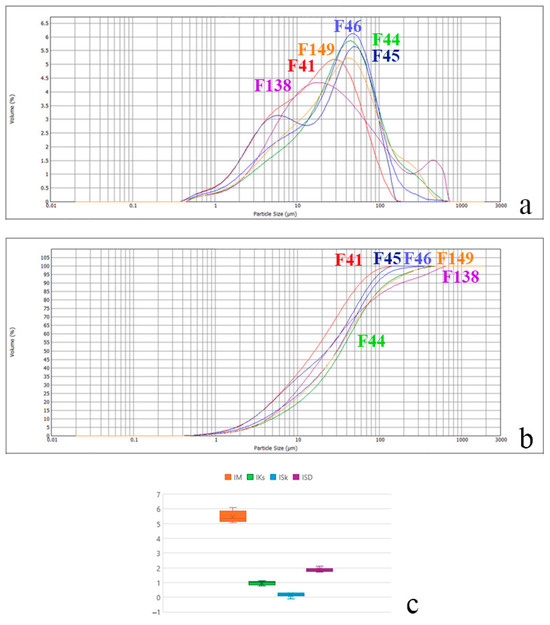
Figure 10.
PSA by laser diffraction of lacustrine sediments (samples: F45, F44, F46, F138, F149, F41). (a) Frequency curves. (b) Cumulative curves. (c) Box diagram reporting the main statistical data. Acronyms—IM: inclusive mean, IKs: inclusive kurtosis, ISk: Inclusive skewness, ISD: Inclusive standard deviation.
The mesoscopic observations on the polished sections of the two samples of hard conglomerates (FHC01, FHC02; Table 1, Figure 8), also made under a stereomicroscope, allowed the identification of clast-supported conglomerates with very well rounded pebbles with minor cobbles in a sandy matrix, deeply cemented by carbonates (Figure 11).
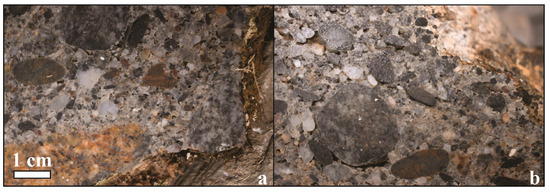
Figure 11.
(a,b). Polished sections of clast-supported hard conglomerates in sandy matrix (sample FHC01) collected along the steep cliff bounding the shallow platform and on this latter.
7.7. Petrographic Data
The mineral sandy to silty particles present in the soft cover (samples: F41, F44, F45A, F46, F138, F149) were observed by visual inspections and analyzed by OM observations under a stereomicroscope and a petrographic microscope. Stereoscopic observations indicated that particles were mainly composed of monomineral siliciclastic grains showing typical features compatible with hyaline quartz, white feldspars, and micas (biotite prevailing), with polycrystalline grains mostly composed of quartz + biotite, quartz + muscovite, and quartz + feldspar paragenesis (lithoclasts of gneiss and granitoids). The same samples analyzed under a petrographic microscope were determined to be quartzo-lithic rich sediments, being composed of metamorphic monomineral quartz, plagioclase, biotite grains (50%, Figure 12), and metamorphic lithics (50%) mainly composed of quartz + plagioclase, quartz + biotite, and quartz + muscovite mineral paragenesis (Figure 12). Peculiar microstructures were recognized in the quartz grains, being pervasively deformed with different joint systems (Figure 12).
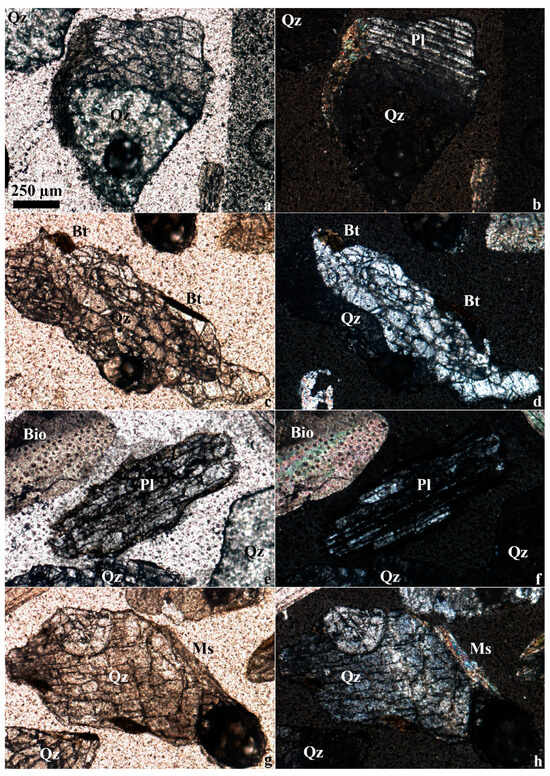
Figure 12.
Petrography of modern mineral grains from the LF soft cover, analyzed in thin sections of aggregated grains in epoxy resin (sample F44). Siliciclastic grains mostly derive from erosion of metamorphic rocks and mostly appear sub-rounded. The main minerals composing the mono- and polymineral grains, in order of abundance, are pervasively fractured quartz, plagioclase, biotite, and muscovite. Remnants of modern bioclasts (mollusks and gastropods) deriving from the mollusk farm are abundant in the sediments. (a,b) Metamorphic polymineral lithoclast, composed of quartz and plagioclase, observed under a microscope, PPL (a), XPL (b). (c,d) Metamorphic polymineral lithoclast, composed of quartz and biotite, observed under a microscope, PPL (c), XPL (d). (e,f) Metamorphic monomineral lithoclast composed of plagioclase preserving tabular habitus, observed under a microscope, PPL (e), XPL (f). (g,h) Metamorphic polymineral lithoclast, composed of quartz and muscovite, observed under a microscope, PPL (g), XPL (h). Acronyms: Qz: Quartz; Pl: Plagioclase; Bt: Biotite; Bio: Bioclast; Ms: Muscovite. PPL: Plane polarized light. XPL: Crossed polarized light. Scale bar is the same in all the images.
The hard conglomerates were determined to be composed of particles of cristalline rocks (high grade metamorphic and igneous rocks) in a quartz prevailing sandy matrix, deeply cemented by carbonates (Figure 11).
7.8. Structural Geology Data
Macroscale field and remote sensing observations were carried out in the study area.
In the Torre Faro-Granatari area, a macroscale fault scarp, bounding the LF and still reported in the literature (normal fault n. 62 in [32]) at the base of the hill, appears with a NNW-SSE/NW-SE trend and ENE dip (Figure 13a).
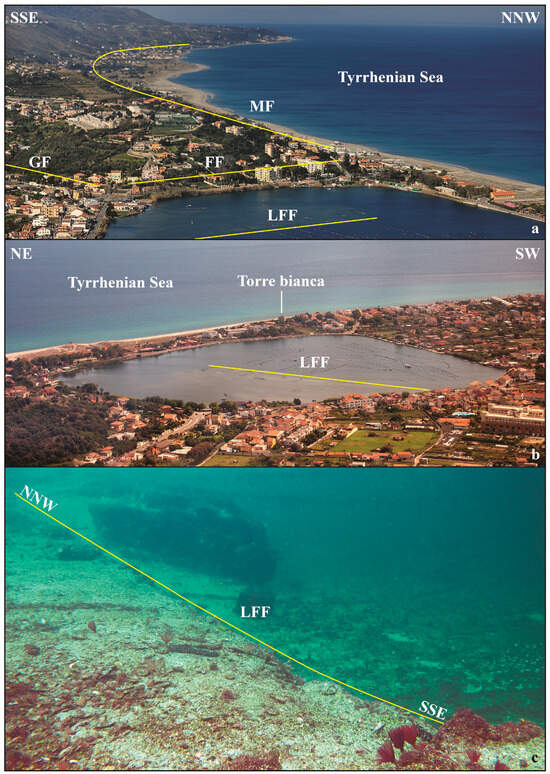
Figure 13.
Main macroscopic faults present in the study area. (a) Transtensional Lake Faro Fault (LFF) observed on an oblique aerial photo of the LF looking ENE-wards. Other faults are also present (normal Mortelle Fault (MF), normal Ganzirri Fault (GF), transtensional Faro Fault (FF). (b) LFF observed on an oblique aerial photograph of the LF looking NW-wards. (c) Subaqueous photograph of the LFF scarp. The fault bounds the shallow platform (on the left) and appears overlain by soft cover.
Parallel to this fault, eastwards, another macroscale structural element was detected underwater in the lake. Indeed, it was determined to be mostly NNW-SSE trending with an ENE dip and NW-wards, E-W oriented. This surface was better observed during the morpho-bathymetric survey and subaqueous snorkeling and SCUBA activities (Figure 13b,c). This fault appeared along the lake platform steep cliff, developing among −2 m and −29 m isobaths, mostly overlain by the soft cover (Figure 13c).
Mesoscale deformation was also searched in the sands and gravels of the middle Pleistocene Messina Formation, representing these deposits in the bedrock of the LF and the surrounding areas. Tens of mesoscale faults, notwithstanding the difficulty to detect deformations in incoherent sediments, were identified (Figure 14). These structures, never detected until now, were characterized on the basis of the fault kinematic indicators and the stratigraphic features shown by the fault hanging walls and footwalls. The main indicators consisted of small cm-sized drag folds allowing the recognition of normal type faults. The entity of the displacement was at cm-scale, reaching maximum values of about 15 cm. The main structural trends of the study mesoscale faults were ENE-WSW, from NNW-SSE to NW-SE, and E-W. The faults were determined to be normal faults, except the NNW-SSE faults were characterized by dextral transtensional displacements (Figure 14).
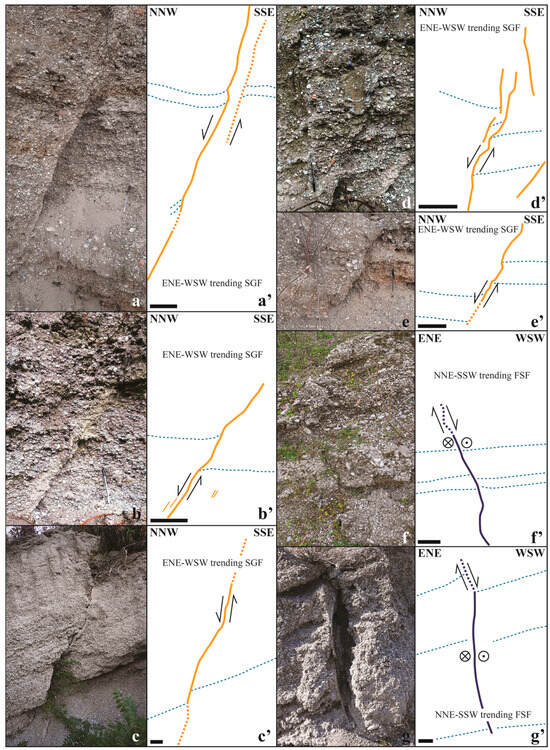
Figure 14.
Photographs (letter) and line drawings (letter’) of the mesoscale faults affecting the Quaternary deposits. (a-a’,b-b’,c-c’,d-d’,e-e’): ENE-WSE trending normal faults of the Scilla Ganzirri Fault System (faults reported in orange color). (f-f’,g-g’): NNE-SSE dextral transtensional faults of the Faro Superiore Fault System (faults reported in blue color). Coordinates of the faults: (a-a’): 38°24′0.47″ N; 15°55′49.16″ E. (b-b’): 38°24′0.568″ N; 15°55′47.25″ E. (c-c’): 38°26′4.835″ N; 15°60′92.66″ E. (d-d’): 38°24′0.568″ N; 15°55′47.25″ E. (e-e’): 38°24′0.802″ N; 15°55′46.19″ E. (f-f’): 38°26′4.86″ N; 15°61′08.25″ E. (g-g’): 38°26′4.86″ N; 15°61′08.25″ E. Symbols: The arrows indicate the sense of movement of the hanging wall and footwall along normal fault. The two circles with a cross and a point indicate a right lateral sense of movement along transtensional fault.
The mesoscale data on the NNW-SSE trending faults allow for better characterization of the macrofaults recognized on the LF area. This is evidence of the tectonic origin of the funnel-shaped depression. The morpho-tectonic structure identified on the LF could represent a tilted block, dominated by transtensional dextral displacements (Figure 15a). Figure 15 illustrates in sketch maps the main macroscale faults affecting the Cape Peloro peninsula, reporting them on topographic surfaces elaborated in [37] with different elevations on the sea level (Figure 15a,b; [37] modified).
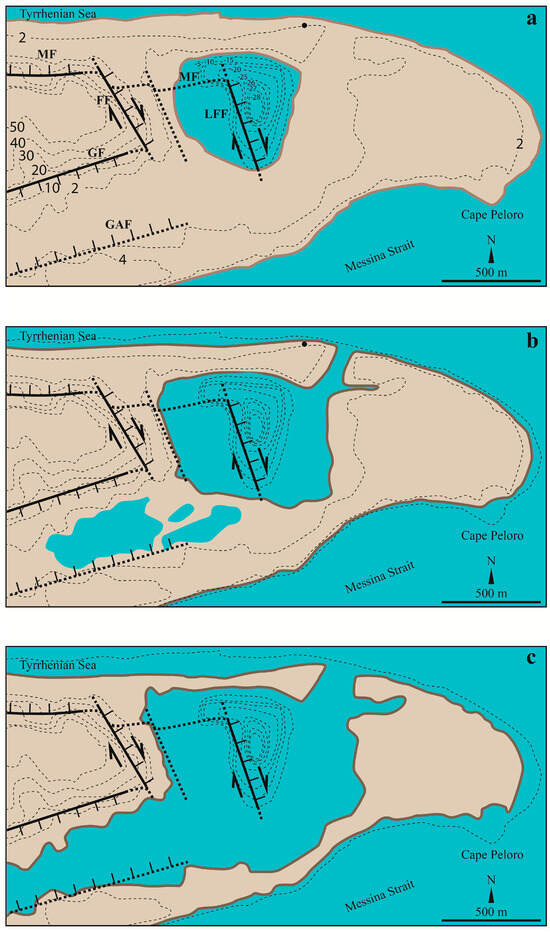
Figure 15.
Interpretative sketch maps showing the main macroscale faults affecting the Cape Peloro peninsula in the late Pleistocene-Holocene time span. Faults are reported on a topographic surface showing different elevations on the sea level (according to [37], modified). (a) Present day topographical surface. (b) Holocene topographical surface with Δh variation of sea level of +1.00 [37]. (c) Holocene topographical surface with Δh variations of sea level of +2.00 m [37]. Reference point: Torre Bianca (black circle). Acronyms: LFF—Lake Faro Fault; FF—Faro Fault; MF—Mortelle Fault; GF—Ganzirri Fault; GAF—Ganzirri Antithetic Fault. Symbols as in Figure 2.
8. Discussion
8.1. Geological Evidence in the Framework of the Northernmost End of the Messina Strait
8.1.1. Stratigraphic Framework
The general Quaternary stratigraphic framework, here first described, was characterized by two different successions.
The lithostratigraphic succession reconstructed in the shallow platform consisted, from top to base, of the following:
- i.
- Soft cover formed by coarse abiotic (siliciclastic sandy gravels) and shell-rich deposits (gravelly sands to gravels with sands), the latter prevailing on the first ones (about 1.5–2 m thick).
- ii.
- Hard conglomerates cemented by carbonates (at least a few meters thick).
- iii.
- Sands and gravels of the Messina Fm (middle Pleistocene).
The coarse abiotic and biotic deposits of the soft cover present in the platform showed very low percentages of mud (silty loams) with biotic carbonatic traces, ranging from 0.06 to 5% (Table 2). The shell-rich deposits, found from the coarse to the fine materials, derived from the ancient clam farming tradition still present today.
In the slopes and deep funnel-like shaped floor, it was only possible to characterize the first soft cover, presumably lying on the Messina Fm (middle Pleistocene), due to the elevated risks for the SCUBA divers operating in dark waters with numerous obstacles of anthropogenic origin. Deep samples consisted of muds (silty loams) with minor amounts of shell-rich gravelly sands and gravels with sands.
The silty loams, found on the shallow and deep environments, were mainly provided of low sorting, fine skewness, and mesokurtic values (Table 3, Figure 10).
In most of the study samples, the percentage of sands composed of clam farming bioclasts appeared to decrease from west to east, along a transect realized from the platform to the deep funnel-shaped floor (Table 2, Figure 8). Indeed, the percentage of shell remains of the soft cover decreased from 82% in the platform up to 19% in the deepest areas. Conversely, the amounts of silty loams appeared to increase from the platform to the deep funnel-shaped floor (Table 2, Figure 8).
The abiotic component of the soft cover was determined to be formed of pebbles of high-grade metamorphic and igneous rocks. Analogously, the siliciclastic sandy to silty particles were determined to be quartzo-lithic rich sediments (particles of metamorphic quartz, plagioclase, biotite, quartz + plagioclase, quartz + biotite, quartz + muscovite, Figure 12). Source rocks of these sediments have been recognized in the granitoids and high-grade metamorphic basements of the Aspromonte Unit and the underlying Messina Fm responsible for nourishing the alluvial and coastal plain of the Cape Peloro peninsula. Indeed, the composition of the LF deposits was determined to be similar to that recently analyzed in the Tyrrhenian and Ionian beaches of the peninsula [27].
8.1.2. Morpho-Bathymetric and Structural Geology Framework
The recent morpho-bathymetric survey, carried out by means of a single-beam ultrasound system, here first described, allowed the definition of the shape and aspects of the LF bottom at high resolution. Indeed, the survey data, further depicting a deep funnel-shaped floor (maximum depth at −29 m), bounded along a steep cliff by a shallow platform to the west (maximum depth at −2 m), as previously recognized [2], allowed better investigation of the platform shape, evidencing the occurrence of a depression parallel to the cliff, on the SW side (Figure 7c,d). The steep cliff showed a NNW-SSE trend switching NW-wards in an E-W trend.
In the Torre Faro-Granatari-LF area, macroscale fault scarps were detected. A fault with NNW-SSE/NW-SE trend and ENE dip (Figure 13) bounds the LF at the base of the hill (FF). Parallel to this scarp eastwards, another fault scarp may be identified in the steep cliff bounding the eastern side of the LF platform. The LFF, mostly NNW-SSE trending, NW-wards switches to E-W. The NNW-SSE surface was better observed during the morpho-bathymetric survey and subaqueous snorkeling and SCUBA activities, developing among −2 m and −29 m isobaths, mostly overlain by the soft cover (Figure 13). Mesoscale structural investigations, carried out in the middle Pleistocene Messina Fm, with these deposits being the substrate of the LF, revealed for the first time the presence of tens of mesoscale faults, parallel to the main macroscale fault system affecting the northern edge of the Messina Strait area (Figure 2). Kinematic indicators were typical of normal type faults, except along the NNW-SSE faults, being characterized by dextral transtensional displacements as in the Faro Superiore or Curcuraci fault system.
Considering the previous hypotheses for interpreting the origin of the LF [29,30], the data here reported should suggest a tectonic genesis for the LF, dominated by an en-echelon system of NNW-SSE dextral transtensional faults (Faro Superiore or Curcuraci Fault system; Figure 15). These Quaternary faults, presumably active since the middle-late(?) Pleistocene, may belong to an active conjugate relay zone where the displacements on the strike-slip faults are transferred to the Messina-Taormina normal fault system within the Messina Strait framework [17].
In the northernmost edge of the Messina Strait, about 11,000–9000 years B.P., stable eastwards littoral warm currents dominated in the Tyrrhenian Sea, and the paleo Lake Faro was presumably linked to the sea [29,37,69].
Archaeological and historiographical data also seem to corroborate this hypothesis, existing evidence of a natural ancient port in the paleo lake, denoted portus Pelori [37], from 2200–2000 B.C. On the other hand, paleotopographic investigation on the Peloro peninsula allowed for the reconstruction of a regional uplift of 1.5 ÷ 2.0 m in the last 2500 years (1.7–2.6 mm/year) [37] (Figure 15b,c).
8.2. Biological Evidence in the Framework of the Northernmost End of the Messina Strait
Literature all agrees on considering bathymetry as the main factor responsible for the peculiar LF ecosystem asset. In this respect, past biological investigation has been especially focused on the deep funnel-shaped portion, due to the sulfide-rich anoxic monimolimnion and related microbial communities [70]. Despite such evidence, however, the knowledge on the effective bathy-morphology of LF and related habitats is the same as in [2], never verified and updated by modern technique employments. The present investigation, although confirming the known general outline, provided a detailed picture of the lake floors. A structure not shown in [2], for example, is the 3 m depth depression located in the SW area of the shallow platform, whose origin and ecological implications need further investigation. For the first time, information, documented by means of visual recognition, has been provided on the main LF habitats. The most impressive structure is the rocky cliff separating the shallow platform from the funnel-shaped area, representing a rare example of a natural hard bottom in a brackish environment. Such a structure, coupled with other ones of anthropogenic origin (exposed hard basements of “sand mounds”), determines a peculiar, patch-distributed, and highly biodiverse habitat, not yet adequately explored. In general, the whole lake floor shows a high human footprint, mainly due to the secular shell farming activity, involving sediment moving and reworking. The same activity, producing a large amount of biological waste, especially shell remains, was responsible for bioclastic deposits in their turn colonized by calcareous red algae. Such secondary substrates show notable affinities with the shallow water rhodolith beds recently described for the Taranto Gulf [71]. Concerning the nepheloid layer and related microbial mats, here first described (Figure 9f), it is presumable that their role in the organic matter recycling in the deep anoxic layers is relevant, as pointed out in other localities worldwide [72,73,74].
Regarding the times and circumstances responsible for the present-day hydrological structure of LF, its primary origin presumably may date back to the Late Pleistocene-Early Holocene, but subsequent transformations are not sufficiently documented. Nothing is known, for example, about the origin and evolution of the anoxic deep-water layer, whose explication in terms of hydrogen sulfide pollution [75] is disputable.
A biological heritage of events occurring during the Late Pleistocene to Holocene time span in the Messina Strait framework is provided by those marine species whose occurrence in the LF biotope can be explained in terms of long-time segregation. In this respect, at least the endemic gastropod Tritia tinei (Maravigna, 1840) should be cited [76]. Similar indications concern crustaceans, such as Siriella clausi (G.O. Sars, 1877), Diamysis bahirensis (G.O. Sars, 1877), and Mysidacaea spp. [77,78], whose interpretation as remnants of species developed during the Younger Dryas Chronozone, and which nevertheless needs further investigation. Indeed, the biological evolution of this lacustrine system, from its origin to today, is unknown. It can be assumed that many transformations have occurred over time, mainly related to the different degree of isolation from the Tyrrhenian Sea, which in turn has been influenced by human interventions [79].
In this respect, the human exploitation of natural resources had a relevant and contrasting role in their maintainance or depletion, with notable implications also in terms of cultural heritage. Unfortunately, seafood remains of prehistoric age are lacking in the LF area, but the exploitation of cockles and clams as food has been documented from the Bronze Age, in the close Messina Strait area. On a multi-millennial scale, moreover, some clues suggest the possible long-term persistence of a Pinna nobilis Linnaeus, 1758 population, or at least recurrent recolonization phases. Greek coins dating back to 5th–4th century B.C., indeed, testify that the “noble fanshell” was the object of a local cult, probably coupled with its exploitation for the lucrative “sea silk” production [80]. Historical sources have also testified about the existence of a dedicated place of veneration, located on the edge of the steep cliff, in the center of the lake “to divide the shallow waters from the deep waters” [81]. Just in the 19th century, moreover, verifiable information on some edible species was reported [82], testifying of a different abundance and availability with respect to the present age. Noteworthy, present-day death assemblages have provided evidence of such events, involving strict relationships of natural and human-mediated changes with the persistence or decline of the local cultural heritage.
9. Conclusions
Interdisciplinary investigastions carried out in the coastal Lake Faro area enabled updating and implementing the knowledge of this particular and rare environment, starting from its bathymorphology, finally investigated with modern techniques.
For the first time, the Quaternary stratigraphy and sedimentology of the clastic deposits have been depicted. Structural investigations allowed for the identification of a NNW-SSE trending right lateral transtensional macroscale fault (LFF), bounding the shallow platform of the LF, which for the first time has been documented by means of subaqueous photographies. NNW-SSE trending right lateral transtensional mesoscale faults were evidenced for the first time in the surrounding outcrops of Quaternary deposits, confirming the direction of movement on the LFF. Such evidence of a tectonic origin of LF makes this basin a rare case study of a tectonic coastal lagoon, similarly to the coastal Lagoon Nador in Morocco, where faults are oriented orthogonally with respect to the coast.
The tectonic origin of LF, lacking significant inputs of both marine and continental sediments, was responsible for long-term stability, which in turn contributed to supporting and maintaining its high environmental and ecological complexity.
In this scenario, human populations and related cultures flourished, significantly leading to the ecological evolution of the basin in historical times.
The present paper, showing an integrated view of geological, ecological, and ethno-anthropological original data, is intended to be a baseline for ongoing and future insights. For example, by applying high-resolution seismic surveys, the architecture and stratigraphy of the geological substrate could be better defined, as well as the geometry of the LFF plane observed between the platform and the deep-seated depression, together with the relative age of the fault and its seismogenic potential.
With regard to the identified habitats and communities, their accurate mapping is ongoing, coupled with accurate faunal and floristic surveys medium-long-term monitoring, aimed to evaluate their main trends.
Finally, ancient and recent human impacts might be better evaluated, for example, throughout stratigraphic investigation coupled with sedimentological, paleontological, and archeological data.
In conclusion, the geological peculiarity, due to its complex origin and formation, made LF very attractive for ancient and recent human settlements. The lake, exploited since the prehistoric age because of high biodiversity and productivity, nowadays maintains some evidence of millennial relationships with the resident human cultures. In this respect, the human footprint is strong, having profoundly altered the recent sedimentary structure of the soft cover and caused the disappearance of some relevant habitats. The most relevant geological peculiarity, nevertheless, remains, explaining the role of the LF as a mondial geosite coupling geological, biological, and cultural heritages.
Author Contributions
Conceptualization, R.S. and S.G.; methodology, R.S. and S.G.; software, E.G. and S.A.; validation, R.S., E.G. and S.G.; formal analysis, R.S. and S.G.; investigation, R.S., E.G., S.A., S.E.S., A.G. and S.G.; resources, R.S., E.G., S.E.S. and S.G.; data curation, R.S., E.G., S.E.S., A.G. and S.G.; writing—original draft preparation, R.S. and S.G.; writing—review and editing, R.S., S.E.S. and S.G.; visualization R.S., S.E.S. and S.G.; supervision, R.S. and S.G. All authors have read and agreed to the published version of the manuscript.
Funding
This research received no external funding.
Data Availability Statement
The original contributions presented in this study are included in the article. Further inquiries can be directed to the corresponding authors.
Acknowledgments
The authors are grateful to the reviewers and editors for strongly improving the paper. The authors want to give a special and deep acknowledgement to Maria Molino (director of the oriented reserve of Cape Peloro, Metropolitan city of Messina) for allowing the authors to accomplish the activities related to the scientific research on Lake Faro.
Conflicts of Interest
The authors declare no conflicts of interest.
References
- Somma, R.; Spoto, S.E.; Giacobbe, S. Geological and Structural Framework, Inventory, and Quantitative Assessment of Geodiversity: The Case Study of the Lake Faro and Lake Ganzirri Global Geosites (Italy). Geosciences 2024, 14, 236. [Google Scholar] [CrossRef]
- Abbruzzese, D.; Genovese, S. Osservazioni geomorfologiche e fisico-chimiche sui laghi di Ganzirri e di Faro. Boll. Pesca Piscic. Idrobiol. 1952, 28, 75–92. [Google Scholar]
- Furfaro, G.; Renda, W.; Nardi, G.; Giacobbe, S. Integrative taxonomy of the bubble snails (Cephalaspidea, Heterobranchia) inhabiting a promising study area: The coastal sicilian Faro Lake (Southern Italy). Water 2023, 15, 2504. [Google Scholar] [CrossRef]
- Lankford, R. Coastal Lagoons of Mexico their origin and classification. In Estuarine Processes; Wiley, M., Ed.; Academic Press: Cambridge, MA, USA, 1977; pp. 182–215. [Google Scholar] [CrossRef]
- Hess, K.; Engel, M.; Patel, T.; Vakhrameeva, P.; Koutsodendris, A.; Klemt, E.; Hansteen, T.H.; Kempf, P.; Dawson, S.; Schön, I.; et al. A 1500-year record of North Atlantic storm flooding from lacustrine sediments, Shetland Islands (UK). J. Quat. Sci 2024, 39, 37–53. [Google Scholar] [CrossRef]
- Barra, D.; Donadio, C.; Lämmle, L.; Perez Filho, A.; Stamatopoulos, L.; Valente, A.; Kontopoulos, N.; Parisi, R.; Stanislao, C.; Aiello, G. Morphogenetic and palaeoenvironmental evolution of the Lagoon of Kotychi in western Peloponnese, Greece, during the Holocene. Quat. Int. 2024, 710, 66–94. [Google Scholar] [CrossRef]
- Raji, O.; Dezileau, L.; Tessier, B.; Niazi, S.; Snoussi, M.; Von Grafenstein, U.; Poujol, A. Climate and tectonic-driven sedimentary infill of a lagoon as revealed by high resolution seismic and core data (the Nador lagoon, NE Morocco). Mar. Geol. 2018, 398, 99–111. [Google Scholar] [CrossRef]
- Ejarque, A.; Julià, R.; Reed, J.M.; Mesquita-Joanes, F.; Marco-Barba, J.; Riera, S. Coastal evolution in a Mediterranean microtidal zone: Mid to Late Holocene natural dynamics and human management of the Castelló lagoon, NE Spain. PLoS ONE 2016, 11, e0155446. [Google Scholar] [CrossRef] [PubMed]
- Bonetti, J.; Del Bianco, F.; Schippa, L.; Polonia, A.; Stanghellini, G.; Cenni, N.; Gasperini, L. Anatomy of Anthropically Controlled Natural Lagoons through Geophysical, Geological, and Remote Sensing Observations: The Valli Di Comacchio (NE Italy) Case Study. Remote Sens. 2022, 14, 987. [Google Scholar] [CrossRef]
- Susini, D.; Vignola, C.; Goffredo, R.; Totten, D.M.; Masi, A.; Smedile, A.; Mazzini, I. Holocene palaeoenvironmental and human settlement evolution in the southern margin of the Salpi lagoon, Tavoliere coastal plain (Apulia, Southern Italy). Quat. Int. 2023, 655, 37–54. [Google Scholar] [CrossRef]
- Lentini, F.; Catalano, S.; Carbone, S. Note Illustrative della Carta Geologica della Provincia di Messina Scala 1: 50.000; S.EL.CA.: Firenze, Italy, 2000; pp. 1–70. [Google Scholar]
- Messina, A.; Somma, R.; Macaione, E.; Carbone, G.; Careri, G. Peloritani continental crust composition (southern Italy): Geological and petrochemical evidence. Boll. Soc. Geol. Ital. 2004, 123, 405–441. [Google Scholar]
- Appel, P.; Cirrincione, R.; Fiannacca, P.; Pezzino, A. Age constraints on Late Paleozoic evolution of continental crust from electron microprobe dating of monazite in the Peloritani Mountains (southern Italy): Another example of resetting of monazite ages in high-grade rocks. Int. J. Earth Sci. 2011, 100, 107–123. [Google Scholar] [CrossRef]
- Cirrincione, R.; Fazio, E.; Fiannacca, P.; Ortolano, G.; Pezzino, A.; Punturo, R. The Calabria-Peloritani Orogen, a composite terrane in Central Mediterranean; Its overall architecture and geodynamic significance for a pre-Alpine scenario around the Tethyan basin. Period. Mineral. 2015, 84, 701–749. [Google Scholar] [CrossRef]
- Navas-Parejo, P.; Somma, R.; Martín-Algarra, A.; Perrone, V.; Rodríguez-Cañero, R. First record of Devonian orthoceratid-bearing limestones in southern Calabria (Italy). Comptes Rendus Palevol. 2009, 8, 365–373. [Google Scholar] [CrossRef]
- Somma, R.; Martin Rojas, I.; Perrone, V. The stratigraphic record of the Alì-Montagnareale Unit (Peloritani Mountains, NE Sicily). Rend. Online Soc. Geol. Ital. 2013, 25, 106–115. [Google Scholar] [CrossRef]
- Dorsey, R.J.; Longhitano, S.G.; Chiarella, D. Structure and morphology of an active conjugate relay zone, Messina Strait, southern Italy. Basin Res. 2024, 36, e12818. [Google Scholar] [CrossRef]
- Barrier, P. Stratigraphie des dépots pliocènes et quaternaires du Détroit de Messine. In Le Détroit de Messine (Italie) Évolution Tectono-Sédimentaire Récente (Pliocéne et Quaternaire) et Environnement Actuel; Barrier, P., Di Geronimo, I., Montenat, C., Eds.; Doc. et Trav. IGAL: Paris, France, 1987; Volume 11, pp. 59–81. [Google Scholar]
- Guarnieri, P.; Pirrotta, C. The response of drainage basins to the late Quaternary tectonics in the Sicilian side of the Messina Strait (NE Sicily). Geomorphology 2008, 95, 260–273. [Google Scholar] [CrossRef]
- Guarnieri, P.; Pirrotta, C. Superficial faulting, landslides and fluvial catchments associated to active structures in the Messina Strait area (Italy). In Proceedings of the EGU, Vienna, Austria, 2–7 April 2006. [Google Scholar]
- Bonfiglio, L.; Violanti, D. Prima segnalazione di Tirreniano ed evoluzione pleistocenica di Capo Peloro (Sicilia nord-orientale). Geogr. Fis. Din. Quat. 1983, 6, 3–15. [Google Scholar]
- Bada, J.L.; Belluomini, G.; Bonfiglio, L.; Branca, M.; Burgio, E.; Delitalia, L. Isoleucine epimerization ages of quaternary Mammals from Sicily. Il Quat. 1991, 4, 49–54. [Google Scholar]
- Bonfiglio, L.; Violanti, D.; Marchetti, M. Il substrato neogenico della Formazione delle Ghiaie di Messina sulla sponda siciliana dello Stretto. Mem. Soc. Geol. Ital. 1991, 47, 27–37. [Google Scholar]
- Antonioli, F.; Kershaw, S.; Renda, P.; Rust, D.; Belluomini, G.; Cerasoli, M.; Radtke, U.; Silenzi, S. Elevation of the last interglacial highstand in Sicily (Italy): A benchmark of coastal tectonics. Quat. Int. 2005, 145, 3–18. [Google Scholar] [CrossRef]
- Guarnieri, P.; Di Stefano, A.; Carbone, S.; Lentini, F.; Del Ben, A. A multidisciplinary approach to the reconstruction of the Quaternary evolution of the Messina Strait (with Geological Map of the Messina Strait 1:25.000 scale). In Mapping Geology in Italy; Pasquarè, G., Venturini, C., Eds.; APAT: Roma, Italy, 2005; pp. 45–50. [Google Scholar]
- Somma, R.; Giacobbe, S.; La Monica, F.P.; Molino, M.L.; Morabito, M.; Spoto, S.E.; Zaccaro, S.; Zaffino, G. Defense and Protection of the Marine Coastal Areas and Human Health: A Case Study of Asbestos Cement Contamination (Italy). Geosciences 2024, 14, 98. [Google Scholar] [CrossRef]
- Somma, R. Petrographic and Textural Characterization of Beach Sands Contaminated by Asbestos Cement Materials (Cape Peloro, Messina, Italy): Hazardous Human-Environmental Relationships. Geosciences 2024, 14, 167. [Google Scholar] [CrossRef]
- Società Stretto di Messina. Progetto definitivo del Ponte sullo Stretto di Messina; Società Stretto di Messina: Roma, Italy, 2011. [Google Scholar]
- Segre, A.G.; Bagnala, R.; Sylos Labini, S. Holocene evolution of the Pelorus headland, Sicily. Quat. Nova 2004, 8, 69–78. [Google Scholar]
- Bottari, A.; Bottari, C.; Carveni, P. Tectonic genesis of the salt marshes on the Sicilian coast of the Straits of Messina (Sicily). Il Quat. Ital. J. Quat. Sci. 2005, 18, 113–122. [Google Scholar]
- Doglioni, C.; Ligi, M.; Scrocca, D.; Bigi, S.; Bortoluzzi, G.; Carminati, E.; Cuffaro, M.; D’Oriano, F.; Forleo, V.; Muccini, F.; et al. The tectonic puzzle of the Messina area (southern Italy): Insights from new seismic reflection data. Sci. Rep. 2012, 2, 970. [Google Scholar] [CrossRef] [PubMed]
- Ghisetti, F. Fault Parameters in the Messina Strait (Southern Italy) and Relations with the Seismogenic Source. Tectonophysics 1992, 210, 117–133. [Google Scholar] [CrossRef]
- Monaco, C.; Tortorici, L. Active Faulting in the Calabrian Arc and Eastern Sicily. J. Geodyn. 2000, 29, 407–424. [Google Scholar] [CrossRef]
- del Ben, A.; Barnaba, C.; Taboga, A. Strike-slip systems as the main tectonic features in the Plio-quaternary kinematics of the Calabrian arc. Mar. Geophys. Res. 2008, 29, 1–12. [Google Scholar] [CrossRef]
- del Ben, A. Technical Report N. 85001; Stretto di Messina S.p.A.: Roma, Italy, 1985. [Google Scholar]
- del Ben, A.; Finetti, I. Technical Report N. 850016; Stretto di Messina S.p.A.: Roma, Italy, 1985. [Google Scholar]
- Bottari, C.; Carveni, P. Archaeological and historiographical implications of recent uplift of the Peloro Peninsula, NE Sicily. Archaeoseismology in Sicily: Past Earthquakes and Effects on ancient Society. Quat. Res. 2009, 72, 38–46. [Google Scholar] [CrossRef]
- Pino, P.; Scolaro, S.; Torre, A.; D’Amico, S.; Neri, G.; Presti, D. Geophysical and geological signatures of an unknown fault in the historic center of Messina (Sicily, south Italy). Ann. Geophys. 2023, 66, SE319. [Google Scholar] [CrossRef]
- Donato, G.; Vázquez-Luis, M.; Nebot-Colomer, E.; Lunetta, A.; Giacobbe, S. Noble fan-shell, Pinna nobilis, in Lake Faro (Sicily, Italy): Ineluctable decline or extreme opportunity. Estuar. Coast. Shelf Sci. 2021, 261, 107536. [Google Scholar] [CrossRef]
- Maugeri, T.L.; Caccamo, D.; Gugliandolo, C. Potentially pathogenic vibrios in brackish waters and mussels. J. Appl. Microbiol. 2000, 89, 261–266. [Google Scholar] [CrossRef] [PubMed]
- Leonardi, M.; Azzaro, F.; Azzaro, M.; Caruso, G.; Mancuso, M.; Monticelli, L.S.; Zaccone, R. A multidisciplinary study of the Cape Peloro brackish area (Messina, Italy): Characterisation of trophic conditions, microbial abundances and activities. Mar. Ecol. 2009, 30, 33–42. [Google Scholar] [CrossRef]
- Saccà, A.; Guglielmo, L.; Bruni, V. Vertical and temporal microbial community patterns in a meromictic coastal lake influenced by the Straits of Messina upwelling system. Hydrobiologia 2008, 600, 89–104. [Google Scholar] [CrossRef]
- Pansera, M.; Granata, A.; Guglielmo, L.; Minutoli, R.; Zagami, G.; Brugnano, C. How does mesh-size selection reshape the description of zooplankton community structure in coastal lakes? Estuar. Coast. Shelf Sci. 2014, 151, 221–235. [Google Scholar] [CrossRef]
- Zagami, G.; Brugnano, C.; Granata, A.; Guglielmo, L.; Minutoli, R.; Aloise, A. Biogeographical distribution and ecology of the planktonic copepod Oithona davisae: Rapid invasion in Lakes Faro and Ganzirri (Central Mediterranean Sea). In Trends in Copepod Studies-Distribution, Biology and Ecology; Uttieri, M., Ed.; Nova Science Publishers: New York, NY, USA, 2015; pp. 59–82. [Google Scholar]
- Genovese, S. Sur la présence d’eau rouge dans le lac de Faro (Messine). Rapp. Procès-Verbaux Réun. Comm. Int. Pour l’Explor. Sci. Mer CIESM 1961, 16, 255–256. [Google Scholar]
- Gugliandolo, C.; Lentini, V.; Maugeri, T.L. Distribution and diversity of bacteria in a saline meromictic lake as determined by PCR-DGGE of 16S rRNA gene fragments. Curr. Microbiol. 2011, 62, 159–166. [Google Scholar] [CrossRef]
- La Cono, V.; La Spada, G.; Arcadi, E.; Placenti, F.; Smedile, F.; Ruggeri, G.; Yakimov, M.M. Partaking of Archaea to biogeochemical cycling in oxygen-deficient zones of meromictic saline Lake Faro (Messina, Italy). Environ. Microbiol. 2013, 15, 1717–1733. [Google Scholar] [CrossRef]
- Acosta Pomar, L.; Bruni, V.; Decembrini, F.; Giuffre, G.; Maugeri, T.L. Distribution and activity of picophytoplankton in a brackish environment. Prog. Oceanogr. 1988, 21, 129–138. [Google Scholar] [CrossRef]
- Brugnano, C.; Guglielmo, L.; Ianora, A.; Zagami, G. Temperature effects on fecundity, development and survival of the benthopelagic calanoid copepod, Pseudocyclops xiphophorus. Mar. Biol. 2009, 156, 331–340. [Google Scholar] [CrossRef]
- Saccà, A.; Strüder-Kypke, M.C.; Lynn, D.H. Redescription of Rhizodomus tagatzi (Ciliophora: Spirotrichea: Tintinnida), Based on Morphology and Small Subunit Ribosomal RNA Gene Sequence. J. Eukaryot. Microbiol. 2012, 59, 218–231. [Google Scholar] [CrossRef] [PubMed]
- Uttieri, M.; Anadoli, O.; Banchi, E.; Battuello, M.; Beşiktepe, Ş.; Carotenuto, Y.; Wootton, M. The distribution of Pseudodiaptomus marinus in European and neighbouring waters—A rolling review. J. Mar. Sci. Eng. 2023, 11, 1238. [Google Scholar] [CrossRef]
- Licata, P.; Trombetta, D.; Cristani, M.; Martino, D.; Naccari, F. Organochlorine compounds and heavy metals in the soft tissue of the mussel Mytilus galloprovincialis collected from Lake Faro (Sicily, Italy). Environ. Int. 2004, 30, 805–810. [Google Scholar] [CrossRef] [PubMed]
- Sorgi, C.; Ferlazzo, M.; Giannetto, S. Cryptosporidium and Giardia in mussels (Mytilus galloprovincialis) from Faro salt–lake, Sicily. Parassitologia 2006, 48, 296. [Google Scholar]
- Cosentino, A.; Giacobbe, S.; Potoschi, A., Jr. The CSI of Faro coastal lake (Messina): A natural observatory for the incoming of marine alien species. Biol. Mar. Mediterr. 2009, 16, 132–133. [Google Scholar]
- Ferrarini, A.; Celada, C.; Gustin, M. Anthropogenic Pressure and Climate Change Could Severely Hamper the Avian Metacommunity of the Sicilian Wetlands. Diversity 2022, 14, 696. [Google Scholar] [CrossRef]
- Marcenò, C.; Romano, S. La vegetazione psammofila della Sicilia settentrionale. Inform. Bot. Ital. 2010, 42, 91–98. [Google Scholar]
- Roma-Marzio, F.; Liguori, P.; Meneguzzo, E.; Banfi, E.; Busnardo, G.; Galasso, G.; Giardini, M. Nuove segnalazioni floristiche italiane 6. Flora vascolare (47–53). Not. Soc. Bot. Ital. 2019, 3, 77–80. [Google Scholar]
- Vitale, D.; Giacobbe, S.; Spinelli, A.; De Matteo, S.; Cervera, J.L. “Opisthobranch” (mollusks) inventory of the Faro Lake: A Sicilian biodiversity hot spot. Ital. J. Zool. 2016, 83, 524–530. [Google Scholar] [CrossRef]
- Furfaro, G.; De Matteo, S.; Mariottini, P.; Giacobbe, S. Ecological notes of the alien species Godiva quadricolor (Gastropoda: Nudibranchia) occurring in Faro Lake (Italy). J. Nat. Hist. 2018, 52, 645–657. [Google Scholar] [CrossRef]
- Giacobbe, S. Biodiversity loss in Sicilian transitional waters: The molluscs of Faro Lake. Biodivers. J. 2012, 3, 501–510. [Google Scholar]
- Giacobbe, S.; Spinelli, A.; De Matteo, S.; Kovačić, M. First record of the large-headed goby, Millerigobius macrocephalus (Actinopterygii: Perciformes: Gobiidae), from Italy. Acta Ichthyol. Piscat. 2016, 46, 49–52. [Google Scholar] [CrossRef]
- Putignano, M.; Gravili, C.; Giangrande, A. The peculiar case of Myxicola infundibulum (Polychaeta: Sabellidae): Echo from a science 200 years old and description of four new taxa in the Mediterranean Sea. Eur. Zool. J. 2023, 90, 506–546. [Google Scholar] [CrossRef]
- Donato, G.; Lunetta, A.; Spinelli, A.; Catanese, G.; Giacobbe, S. Sanctuaries are not inviolable: Haplosporidium pinnae as responsible for the collapse of the Pinna nobilis population in Lake Faro (central Mediterranean). J. Invertebr. Pathol. 2023, 201, 108014. [Google Scholar] [CrossRef] [PubMed]
- Spagnuolo, D.; Gatì, I.; Manghisi, A.; Morabito, M.; Giacobbe, S. Shallow rhodolith beds in Capo Peloro Lagoon. Biol. Mar. Mediterr. 2024, 28, 145–148. [Google Scholar]
- International Hydrographic Bureau IHO. Manual of Hydrography, 1st ed.; Publication M–13; International Hydrographic Bureau: Monaco, Germany, 2005; pp. 1–46. [Google Scholar]
- Pérès, J.M.; Picard, J. Nouveau manuel de bionomie benthique de la mer Méditerranée. Nouveau manuel de bionomie benthique. Recl. Trav. Stn. Mar. d’Endoume 1964, 31, 5–137. [Google Scholar]
- Montefalcone, M.; Tunesi, L.; Ouerghi, A. A review of the classification systems for marine benthic habitats and the new updated Barcelona Convention classification for the Mediterranean. Mar. Environ. Res. 2021, 169, 105387. [Google Scholar] [CrossRef]
- WoRMS (World Register of Marine Species). Available online: https://www.marinespecies.org/aphia.php?p=taxdetails&id=14078 (accessed on 30 September 2024).
- Chillemi, F. Capo Peloro e la spiaggia di Tono. In I Casali di Messina. Strutture Urbane e Patrimonio Artistico; EDAS Editore: Messina, Italy, 1995; pp. 63–68. [Google Scholar]
- Raffa, C.; Rizzo, C.; Strous, M.; de Domenico, E.; Sanfilippo, M.; Michaud, L.; lo Giudice, A. Prokaryotic dynamics in the meromictic coastal Lake Faro (Sicily, Italy). Diversity 2019, 11, 37. [Google Scholar] [CrossRef]
- Pierri, C.; Longo, C.; Falace, A.; Gravina, M.F.; Gristina, M.; Kaleb, S.; Albano, P.G. Invertebrate diversity associated with a shallow rhodolith bed in the Mediterranean Sea (Mar Piccolo of Taranto, south-east Italy). Aquat. Conserv. Mar. Freshw. 2024, 34, e4054. [Google Scholar] [CrossRef]
- Simon, M.; Grossart, H.P.; Schweitzer, B.; Ploug, H. Microbial ecology of organic aggregates in aquatic ecosystems. Aquat. Microb. Ecol. 2002, 28, 175–211. [Google Scholar] [CrossRef]
- Kim, J.H.; Park, M.H.; Tsunogai, U.; Cheong, T.J.; Ryu, B.J.; Lee, Y.J.; Chang, H.W. Geochemical characterization of the organic matter, pore water constituents and shallow methane gas in the eastern part of the Ulleung Basin, East Sea (Japan Sea). Isl. Arc 2007, 16, 93–104. [Google Scholar] [CrossRef]
- Engel, A.; Meyerhöfer, M.; von Bröckel, K. Chemical and biological composition of suspended particles and aggregates in the Baltic Sea in summer (1999). Estuar. Coast. Shelf Sci. 2002, 55, 729–741. [Google Scholar] [CrossRef]
- Crisafi, P. Un anno di ricerche fisico-chimiche continuative sui laghi di Ganzirri e Faro. Boll. Pesca Piscic. Idrobiol. 1954, 30, 89–115. [Google Scholar]
- Sabelli, B.; Taviani, M. The Making of the Mediterranean Molluscan Biodiversity. In The Mediterranean Sea; Goffredo, S., Dubinsky, Z., Eds.; Springer: Dordrecht, The Netherlands, 2014; pp. 285–306. [Google Scholar] [CrossRef]
- Genovese, S. Su due Misidacei dei laghi di Ganzirri e di Faro (Messina). Ital. J. Zool. 1956, 23, 177–197. [Google Scholar] [CrossRef]
- Ariani, A.P.; Wittmann, K.J.; Franco, E. A comparative study of static bodies in mysid crustaceans: Evolutionary implications of crystallographic characteristics. Biol. Bull. 1993, 185, 393–404. [Google Scholar] [CrossRef]
- Manganaro, A.; Pulicanò, G.; Sanfilippo, M. Temporal evolution of the area of Capo Peloro (Sicily, Italy) from pristine site into urbanized area. Transit. Waters Bull. 2012, 5, 23–31. [Google Scholar] [CrossRef]
- Giacobbe, S.; Caltabiano, M.; Puglisi, M. The Pelorias shell in the ancient coins: Taxonomic attribution and implication in the management of Capo Peloro and Laghi di Ganzirri CSI. Biol. Mar. Mediterr. 2009, 16, 134–135. [Google Scholar]
- Solino, G. Delle cose maravigliose del mondo-Giovan Vincenzo Belprato. Appresso Gabriel Giolito Dè Ferrari Vinegia 1559, 47–50. [Google Scholar]
- Power, J. Guida per la Sicilia. In Guida Per la Sicilia. Ristampa anastatica; D’Angelo, M., Power, J., Eds.; Stabilimento Poligrafico di Filippo Cirelli: Napoli, Italy, 1842; pp. 1–381. [Google Scholar]
Disclaimer/Publisher’s Note: The statements, opinions and data contained in all publications are solely those of the individual author(s) and contributor(s) and not of MDPI and/or the editor(s). MDPI and/or the editor(s) disclaim responsibility for any injury to people or property resulting from any ideas, methods, instructions or products referred to in the content. |
© 2024 by the authors. Licensee MDPI, Basel, Switzerland. This article is an open access article distributed under the terms and conditions of the Creative Commons Attribution (CC BY) license (https://creativecommons.org/licenses/by/4.0/).